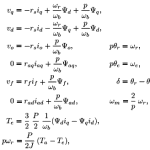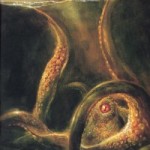
A species of holothurian, Pannychia, swarms a whale fecal mound in the abyssal Pacific.

A degraded whale fecal mound from 2301m in the Pacific Ocean.
New findings by S. Khat et al. provide more evidence for my hypothesis. The paper actually describes findings originally made by Jean-Michel Cousteau (yes that Cousteau, and third author on the study) in 2006 on the Pacific Ocean floor west of Hawaii. From the paper’s abstract…
On February 6, 2006, we discovered an unusual assemblage of deep-sea animals associated with a well-preserved organic mounds at 2891 m depth 281 nautical miles west of Niihau in the Hawaiian Island Chain. Approximately 40 of the mounds, the larges 1.93m in length, were seen in submersible transects over an area of approximately 5km square. Utilizing two nuclear (18S and 28S rRNA) and two mitochondrial genes (COI and ND4), we determined that the organic mounds originated from Balaenoptera musculus. Several other gene sequences were also extracted from the samples and compared to sequences on GeneBank. Several of these sequences were consistent with typical prey items of the B. musculus (e.g. Euphausia pacifica, Thysanoessa inermis, Thysanoessa longipes, Thysanoessa spinifera, Nyctiphanes symplex and Nematoscelis megalops). This genetic evidence, and visual identification of the mounds by an expert, suggests that the mounds represent organic waste egested by B. musculus. Sample from 21 of the 40 fecal mounds indicates originations with at least 12 different individuals. Each mound is estimated to deliver approximately 200 kg of organic material to a typically food-limited seafloor. Particularly noteworthy are the large number of opportunistic deep-sea species, and an abundance of unusual polychaetes. Two of these polychaetes, a spionid and a siboglinid, and a holothurian are new to science.
 According to the paper, the “organic enrichment” increased biodiversity from an average of 61 species per meter square in the background to well over 100 species per meter square near the fecal mounds. The new holothurian (Sheril will be happy) is named Parastichopus stercus and is a member of the family of the warty sea cucumbers (right). Cousteau noted in the press release in Science Daily
According to the paper, the “organic enrichment” increased biodiversity from an average of 61 species per meter square in the background to well over 100 species per meter square near the fecal mounds. The new holothurian (Sheril will be happy) is named Parastichopus stercus and is a member of the family of the warty sea cucumbers (right). Cousteau noted in the press release in Science Daily
“For sixteen months we have been waiting for this moment to share our findings of this unique habitat with the public. It is a very exciting time in which technology allows us to explore, previously inaccessible parts of the ocean. It is a very important time for us and the people who have put the pieces together painstakingly.”
A graduate student of Khat, Bethane Fessies who also authors the study noted “The samples were really foul smelling and fishy, most of us who sorted the samples weren’t able to eat for a couple of days.”
Khat, S., Fessies, B., Cousteau, J-M. (2008). Description of A New Deep-Sea Habitat Based On Whale Feces. Deep Sea Research Part I: Oceanographic Research Papers, 4(01), 401-401. DOI: 04.01/j.dsr.2008.04.01






Whale poo + April 1…..
And yet, it sounds so logical… I’m torn.
brilliant, hilarious, perfect
So when’s paper no. 2 coming out?
my all-time fave line:
…we discussed over lunch my current “great” hypothesis.
also great:
dr. s. khat…
brilliant!
It makes sense. Beetles flock to elephant poo; holothurians flock to whale poo.
Did you know you can buy dehydrated “Zoo Poo” from Toronto’s Metro Zoo?
I like the straightforward hypothesis, but it seems like your example is mixing cause and effect. Hydrothermal vents, whale fall communities, etc… don’t exist in shallow communities because they are non-random environments, not because there are other food sources. After all, not having food isn’t going to make a vent spontaneously open up. Also, it seems to me that whale fall communities may simply be more transient in shallow water communities because of rapid consumption/decomposition.
You get methane seeps in shallow water and the hydrothermal vents in Lake Baikal are at only about 400m. None of them have the kinds of indigenous fauna that we see at deep sea sites.
Please note the above was an April Fool’s Joke…or was it? No really all a joke people step away from the post. Clues? Scientists names (S. Khat & Fessies), cucumber name (stercus is Latin for feces), dates on articles, and Balaenoptera has liquid poo. Abstract is modified from this
http://www.sciencedirect.com/science?_ob=ArticleURL&_udi=B6VGB-4D3W313-2&_user=521395&_rdoc=1&_fmt=&_orig=search&_sort=d&view=c&_acct=C000059570&_version=1&_urlVersion=0&_userid=521395&md5=f08bb9e08b66fa1bcd26f956a8d58f78
*giggles*
But David, there are many shallow water vents. I might have to do a post on them, but there are some stark differences. Also whale caracasses sunk in shallow water (~30m) off of Sweden developed similar communities to deep sea whale fall communities, including new species of the bone-devouring worm, Osedax
LOL!
from somebody who has tried (quite hard … lol) to collect whale poo … 1.93 meters of whale poo at … 2891 m depth?
Would have to have the consistency of concrete!
LOL!
Incidentally, “whale fecal mound” was my brother Benny’s nickname in elementary school.
I’ve been had. HAD! Thanks.